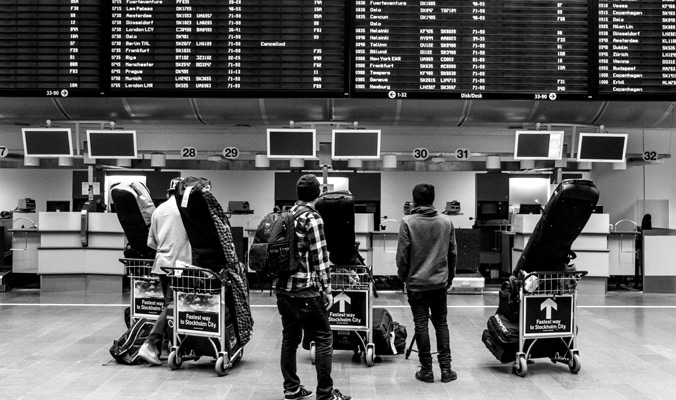
Leavin’ Arlanda, Sweden on a jet plane. [Photo] Markus Alatalo
Do Your Homework
The recipe for a successful trip begins at home with lots of research—where to fly into, how to reach an intended zone, weather, snowpack, lodging, timing, objectives and options, etc. “The Internet can only take us so far, but it’s a good place to start,” says Kit DesLauriers, who estimates she spent at least 25 hours digging up information on the Spanish Pyrenees, which she traveled to last March. “I like to be successful, so it’s really important to gain as much knowledge and to study as much as you can about an area.”
“Gathering information about our destination was a real patchwork of planning,” says Aaron Jamieson, who spent four weeks skiing in Australia’s remote Kosciusko National Park in 2014. He and his crew dug deep into the Internet and even library archives to research the region where they were headed; they spoke with the national parks about safety and emergency plans and extensively cross referenced paper maps with Google maps.
“Frankly,” DesLauriers adds of her trip, “I spent days on Google Earth until I could really picture what it looked like when I’d get there, so it would not be a big surprise.”
Work Your Contacts
“Many of my most successful trips have been with connecting with locals,” says Noah Howell, who traveled to New Zealand last fall. Howell suggests tapping into an on-the-ground resource, like a hut owner, guide or shop employee, for real-time snowpack information or for insight into logistical elements like weather windows, bus travel or emergency resources.
DesLauriers adds that establishing a solid contact can take persistence—reaching out to friends of friends of friends—but it’s always worth it, particularly when combined with any prior homework. “If you’re going to meet up with somebody local, it gives you a lot of credibility when you’ve done that background work,” she says. “You’re really showing respect.”
Build Your Game Plan
“Surprises in the mountains are best avoided by good planning,” says Jamieson. When organizing his expedition, different partners took different planning aspects to fully vet, like food, rescue options or camping locations. “Pinpointing camps on the map was crucial,” he notes, “but having flexibility and the possibility to move sites as required is also key.”
Howell echoes the importance of flexibility in any game plan. For example, on a recent trip to Alaska, he and his crew considered three different mountain-range options and decided which to fly into based on conditions upon arriving in Alaska. “Keep your options open when planning to not lock yourself into specific locations or dates—if at all possible,” he says. “I think three weeks is a minimum if you’re going international or to Alaska. But obviously, if you can’t, its better to roll the dice than not go.”
Hit The Ground Running
“The beauty of the trip unfolds in the moment,” DesLauriers says. “It’s not hyper planned but you still have a great base knowledge of what you’re getting into.” Tap into that game plan upon arrival, executing what’s organized while pivoting—tapping into your background research and resources—as necessary.
That’s the time, Howell adds, to start closely watching the snow, too. “Start gobbling up information when you’re on the ground—it’s just awareness and observation time,” he says. “Sometimes you’ve gotta ease into it; sometimes it’s just go time.” The latter is how his 2015 trip to New Zealand unfolded: he and his crew skied the country’s tallest peak, Aoraki/Mt. Cook (12,218 ft.), on just their second day there.
—
This article was originally published in October 2015 in the Travel Issue. To read more about the trips in this article, pick up a copy here.











Related posts:
Mountain Skills: Knowing When To Turn Around
Hips Don’t Lie: How a solid foundation leads to strong skinning
Mountain Skills: Phone Frenzy
Mountain Skills: The dos and don’ts of quick pits